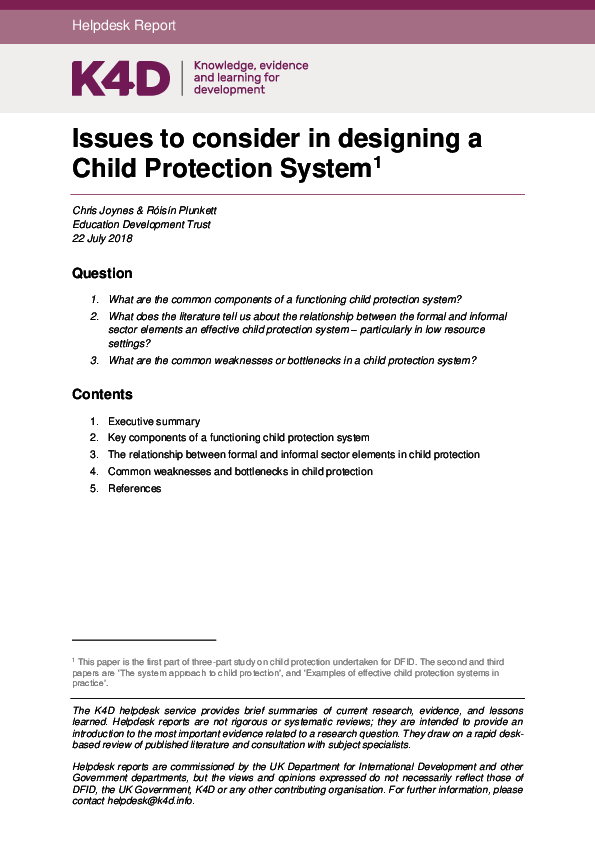
Study: Research
Issues to Consider in Designing a Child Protection System
Publication year:
2018
English
Format:
pdf (634.7 KiB)
Publisher:
K4D, Knowledge, Evidence, and Learning for Development
This rapid review synthezises literature on common components of a functioning child protection system. It draws on number of evidence to identify the relationship between the formal and informal sector elements an effective child protection system, particularly in low resource setting. However, this review does not look in detail at child protection in emergency or crisis settings. The review found that service delivery is commonly comprised of the following components: laws and policies, governance, finance, protection and response services, care management and regulation. However, the evidence also suggests that the following components are also key in enabling the effective delivery of child protection services: Human resources and the social workforce, monitoring and data collection, and public engagement and awareness ((UNICEF, 2013; Thompstone et al. 2014; Wessells 2015; Save The Children 2008). Evidence suggests that, in low resource settings in particular, a range of non-formal and informal mechanisms informed by traditional and/or community-based practices play an important role in providing child protection, particularly in isolated or rural settings where formal state-based provision is under-resourced (Thompstone et al. 2014; Wessells 2015; Kreuger 2014). However, there are a number of challenges in ensuring an effective relationship between formal and informal sector elements, including a lack of regulation and oversight, differing conceptions of child protection, and a frequent lack of engagement by or with formal systems. Common weakness and bottlenecks in child protection systems, particularly in low-resource settings, include but are not limited to: poor implementation of system-wide frameworks for regulation, a need for meaningful engagement with public understandings of child protection, weaknesses in service provision at local level, limited capacity and capability of the social workforce and lack of evidence and knowledge based on data (Krueger et al., 2014; Wessells et al., 2015; Thompstone et al., 2014; Save The Children, 2008). The strength of evidence found was strong in terms of design approaches and key components of child protection, although the majority of documents on this theme date from 2008-2011 and do not appear to have been updated since then. The evidence frequently mentions gender as a specific area of focus when discussing child protection services, but did not discuss gender as an issue in the context of effective development of child protection systems. However, this review did not include disability as a focus in these considerations.
Read full abstract
Authors
View & Download
English
1 Documents
Document information
Authors
Format
Content type
Rights
© Author/Publisher
Found a mistake? Help us improve!
If you have noticed a document assigned to the wrong author or any other inaccuracies, let us know! Your feedback helps us keep our data accurate and useful for everyone.
Share
Link
